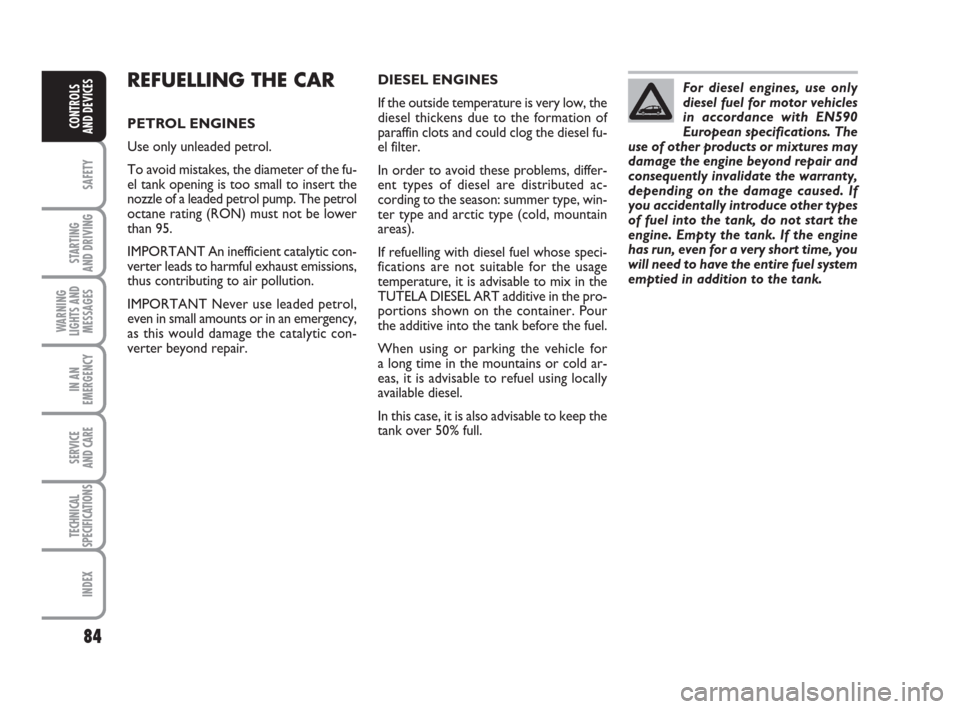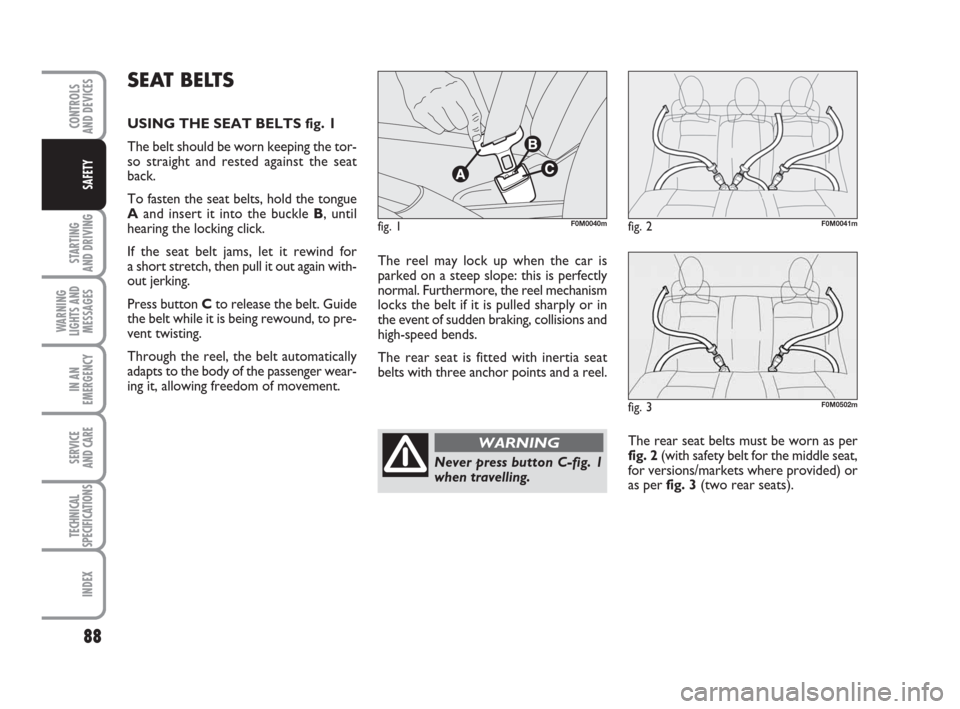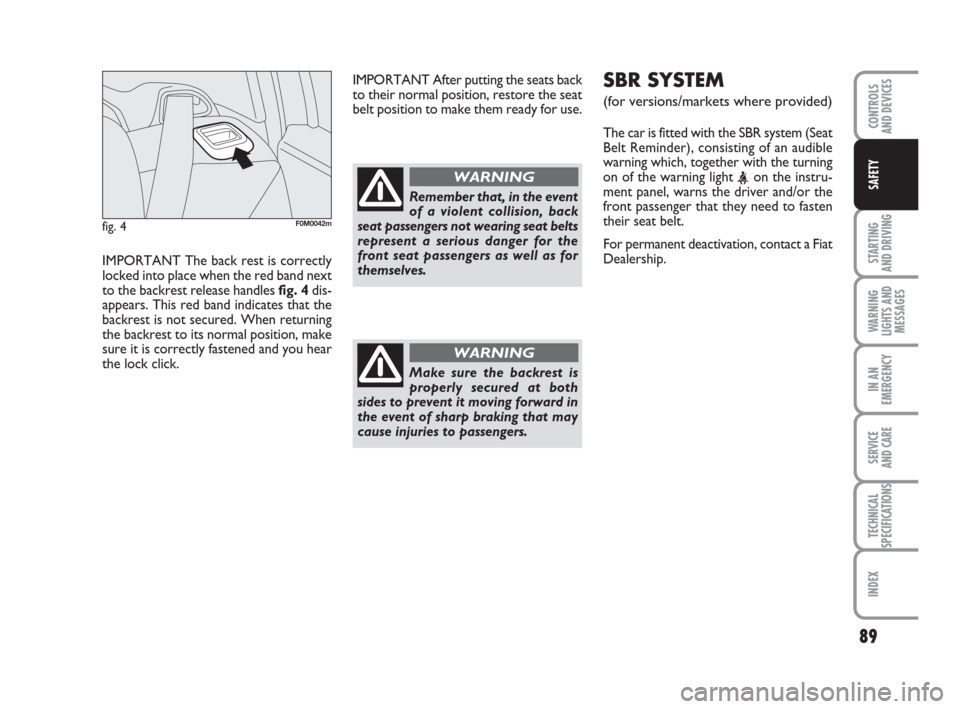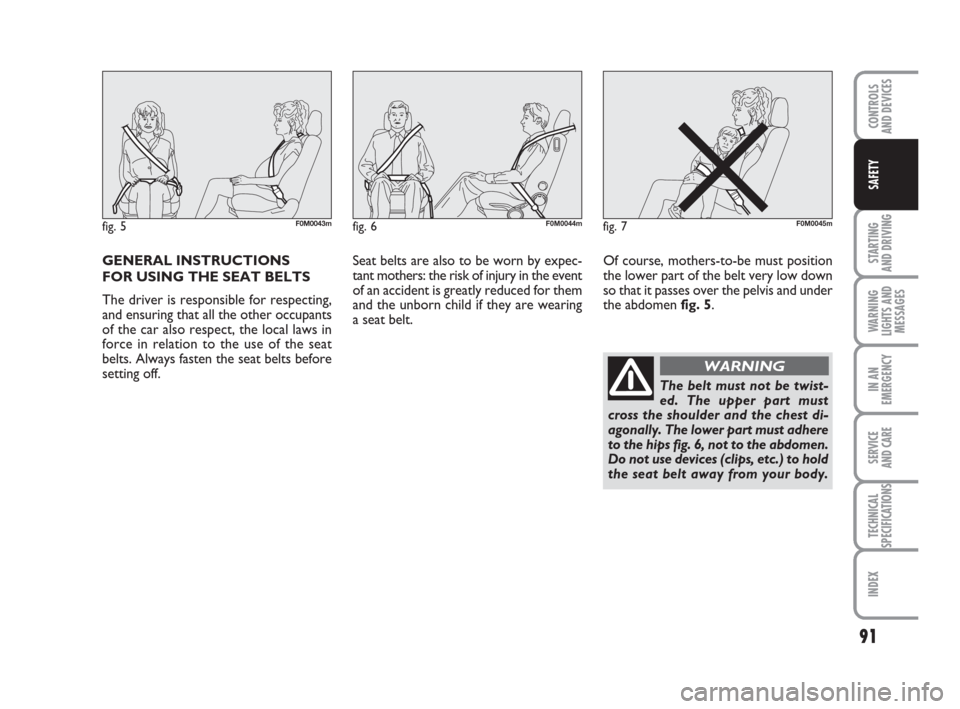2009 FIAT GRANDE PUNTO technical specifications
[x] Cancel search: technical specificationsPage 85 of 210

84
SAFETY
STARTING
AND DRIVING
WARNING
LIGHTS AND
MESSAGES
IN AN
EMERGENCY
SERVICE
AND CARE
TECHNICAL
SPECIFICATIONS
INDEX
CONTROLS
AND DEVICES
REFUELLING THE CAR
PETROL ENGINES
Use only unleaded petrol.
To avoid mistakes, the diameter of the fu-
el tank opening is too small to insert the
nozzle of a leaded petrol pump. The petrol
octane rating (RON) must not be lower
than 95.
IMPORTANT An inefficient catalytic con-
verter leads to harmful exhaust emissions,
thus contributing to air pollution.
IMPORTANT Never use leaded petrol,
even in small amounts or in an emergency,
as this would damage the catalytic con-
verter beyond repair.DIESEL ENGINES
If the outside temperature is very low, the
diesel thickens due to the formation of
paraffin clots and could clog the diesel fu-
el filter.
In order to avoid these problems, differ-
ent types of diesel are distributed ac-
cording to the season: summer type, win-
ter type and arctic type (cold, mountain
areas).
If refuelling with diesel fuel whose speci-
fications are not suitable for the usage
temperature, it is advisable to mix in the
TUTELA DIESEL ART additive in the pro-
portions shown on the container. Pour
the additive into the tank before the fuel.
When using or parking the vehicle for
a long time in the mountains or cold ar-
eas, it is advisable to refuel using locally
available diesel.
In this case, it is also advisable to keep the
tank over 50% full.For diesel engines, use only
diesel fuel for motor vehicles
in accordance with EN590
European specifications. The
use of other products or mixtures may
damage the engine beyond repair and
consequently invalidate the warranty,
depending on the damage caused. If
you accidentally introduce other types
of fuel into the tank, do not start the
engine. Empty the tank. If the engine
has run, even for a very short time, you
will need to have the entire fuel system
emptied in addition to the tank.
072-086 ACTUAL 1ed EN 28-08-2009 8:55 Pagina 84
Page 86 of 210

85
SAFETY
STARTING
AND DRIVING
WARNING
LIGHTS AND
MESSAGES
IN AN
EMERGENCY
SERVICE
AND CARE
TECHNICAL
SPECIFICATIONS
INDEX
CONTROLS
AND DEVICES
FUEL TANK CAP fig. 101
To carry out refuelling, open lid Aand un-
screw cap B; the cap is fitted with a de-
vice Cwhich fastens it to the lid so it can-
not be mislaid.
In some versions, cap Bmay be provided
with a lock and key; use the ignition key
to access the flap A, turn it anti-clockwise
and unscrew the cap itself.
The hermetic seal may cause a slight in-
crease in pressure in the tank. A suction
noise when you release the cap is there-
fore entirely normal.
When refuelling, hook the cap onto the
device inside the lid as shown in fig. 101.
fig. 101F0M0138m
Do not place naked flames
or lit cigarettes near to the
fuel tank opening: fire risk. Keep your
face away from the fuel tank open-
ing to avoid breathing in harmful
vapours.
WARNING
Filling the tank
To fill the tank completely, top up twice
after the first click of the trigger. Further
top ups could cause faults in the fuel sup-
ply system.
PROTECTING
THE ENVIRONMENT
The devices for reducing petrol engine
emissions are the following:
❒three-way catalytic converter;
❒Lambda sensors;
❒fuel evaporation prevention system.
In addition, do not let the engine run, even
for a test, with one or more spark plugs
disconnected.
The following devices are used for reduc-
ing diesel fuel engine emissions:
❒oxidising catalytic converter;
❒exhaust gas recirculation system (E.G.R.);
❒diesel particulate filter (DPF) (for ver-
sions/markets where provided).
072-086 ACTUAL 1ed EN 28-08-2009 8:55 Pagina 85
Page 87 of 210

86
SAFETY
STARTING
AND DRIVING
WARNING
LIGHTS AND
MESSAGES
IN AN
EMERGENCY
SERVICE
AND CARE
TECHNICAL
SPECIFICATIONS
INDEX
CONTROLS
AND DEVICES
The catalytic converter
reaches high temperatures
during normal operation. Do not
park the on grass, dry leaves, pine
needles or other flammable materi-
al: fire hazard.
WARNING
DIESEL PARTICULATE
FILTER (DPF)
(for versions/markets where provided)
The Diesel Particulate Filter is a mechan-
ical filter, integral with the exhaust system,
that physically traps particulates present
in the exhaust gases of diesel engines.
The diesel particulate filter is needed to
eliminate almost all particulates in com-
pliance with current/future legislation.
During normal use of the vehicle, the en-
gine control unit records a set of data (e.g.
travel time, type of route, temperatures,
etc.) and it will then calculate how much
particulate has been trapped by the filter.
Since this filter physically traps particu-
late, it should be regenerated (cleaned)
at regular intervals by burning the carbon
particles.
The regeneration procedure is handled
automatically by the engine control unit
according to the filter conditions and ve-
hicle use conditions.During regeneration, there may be: a lim-
ited increase in minimum revs, a slight in-
crease in fumes and high exhaust temper-
atures. These are not faults; they do not
impair vehicle performance or damage the
environment.
If the dedicated message is displayed, re-
fer to the “Warning lights and messages”
section.
The diesel particulate filter
(DPF) reaches high temper-
atures during normal operation. Do
not park the vehicle on grass, dry
leaves, pine needles or other flam-
mable material: fire hazard.
WARNING
072-086 ACTUAL 1ed EN 28-08-2009 8:55 Pagina 86
Page 88 of 210

87
STARTING
AND DRIVING
WARNING
LIGHTS AND
MESSAGES
IN AN
EMERGENCY
SERVICE
AND CARE
TECHNICAL
SPECIFICATIONS
INDEX
CONTROLS
AND DEVICES
SAFETY
SEAT BELTS ........................................................................... 88
SBR SYSTEM .......................................................................... 89
PRETENSIONERS ................................................................ 90
CARRYING CHILDREN SAFELY ..................................... 93
FRONT AIRBAGS ................................................................ 98
SIDE AIRBAGS ...................................................................... 101
S S
A A
F F
E E
T T
Y Y
087-104 ACTUAL 1ed EN 28-08-2009 8:55 Pagina 87
Page 89 of 210

88
STARTING
AND DRIVING
WARNING
LIGHTS AND
MESSAGES
IN AN
EMERGENCY
SERVICE
AND CARE
TECHNICAL
SPECIFICATIONS
INDEX
CONTROLS
AND DEVICES
SAFETY
The reel may lock up when the car is
parked on a steep slope: this is perfectly
normal. Furthermore, the reel mechanism
locks the belt if it is pulled sharply or in
the event of sudden braking, collisions and
high-speed bends.
The rear seat is fitted with inertia seat
belts with three anchor points and a reel.
The rear seat belts must be worn as per
fig. 2(with safety belt for the middle seat,
for versions/markets where provided) or
as per fig. 3(two rear seats).
SEAT BELTS
USING THE SEAT BELTS fig. 1
The belt should be worn keeping the tor-
so straight and rested against the seat
back.
To fasten the seat belts, hold the tongue
Aand insert it into the buckle B, until
hearing the locking click.
If the seat belt jams, let it rewind for
a short stretch, then pull it out again with-
out jerking.
Press button Cto release the belt. Guide
the belt while it is being rewound, to pre-
vent twisting.
Through the reel, the belt automatically
adapts to the body of the passenger wear-
ing it, allowing freedom of movement.
fig. 1F0M0040mfig. 2F0M0041m
fig. 3F0M0502m
Never press button C-fig. 1
when travelling.
WARNING
087-104 ACTUAL 1ed EN 28-08-2009 8:55 Pagina 88
Page 90 of 210

IMPORTANT The back rest is correctly
locked into place when the red band next
to the backrest release handles fig. 4dis-
appears. This red band indicates that the
backrest is not secured. When returning
the backrest to its normal position, make
sure it is correctly fastened and you hear
the lock click.
89
STARTING
AND DRIVING
WARNING
LIGHTS AND
MESSAGES
IN AN
EMERGENCY
SERVICE
AND CARE
TECHNICAL
SPECIFICATIONS
INDEX
CONTROLS
AND DEVICES
SAFETY
fig. 4F0M0042m
Remember that, in the event
of a violent collision, back
seat passengers not wearing seat belts
represent a serious danger for the
front seat passengers as well as for
themselves.
WARNING
Make sure the backrest is
properly secured at both
sides to prevent it moving forward in
the event of sharp braking that may
cause injuries to passengers.
WARNING
IMPORTANT After putting the seats back
to their normal position, restore the seat
belt position to make them ready for use.SBR SYSTEM
(for versions/markets where provided)
The car is fitted with the SBR system (Seat
Belt Reminder), consisting of an audible
warning which, together with the turning
on of the warning light
front passenger that they need to fasten
their seat belt.
For permanent deactivation, contact a Fiat
Dealership.
087-104 ACTUAL 1ed EN 28-08-2009 8:55 Pagina 89
Page 91 of 210

PRETENSIONERS
To increase the efficiency of the seat belts,
the car is fitted with front pretensioners.
These devices, in the event of a violent
crash, rewind the seat belts by a few cen-
timetres. In this way, they ensure that the
seat belt adheres perfectly to the wearer
before the restraining action begins.
The seat belt reel locks to indicate that the
pretensioners have intervened; the seat
belt cannot be drawn back up even when
guiding it manually.
IMPORTANT To obtain the highest de-
gree of protection from the action of the
pretensioning device, wear the seat belt
tight to the chest and pelvis.
A slight amount of smoke may be detect-
ed during operation of the pretensioners.
This smoke is not harmful and does not
indicate a fire.
The pretensioner does not require any
maintenance or lubrication.
Anything that modifies its original condi-
tions invalidates its efficiency.
If, due to unusual natural events (floods,
sea storms, etc.), the device has been
affected by water and mud, it must be
replaced.LOAD LIMITERS
To increase passenger safety, the front
seat belt reels contain a load limiter which
controls the force acting on the chest and
shoulders during the belt restraining ac-
tion in the event of a head-on collision.
90
STARTING
AND DRIVING
WARNING
LIGHTS AND
MESSAGES
IN AN
EMERGENCY
SERVICE
AND CARE
TECHNICAL
SPECIFICATIONS
INDEX
CONTROLS
AND DEVICES
SAFETY
The pretensioner can be
used only once. Go to a Fiat
Dealership to have it replaced after
it has been deployed. Consult the
card in the glove box to check the sta-
tus of the pretensioners. Go to a Fiat
Dealership to have the device re-
placed when the expiration date
approaches.
WARNING
Operations which lead to
knocks, vibrations or lo-
calised heating (over 100 °C
for a maximum of 6 hours) in
the area around the pretensioners may
cause damage or trigger them. These
devices are not affected by vibrations
caused by irregularities of the road sur-
face or low obstacles such as kerbs,
etc. Contact a Fiat Dealership for any
assistance.
087-104 ACTUAL 1ed EN 28-08-2009 8:55 Pagina 90
Page 92 of 210

GENERAL INSTRUCTIONS
FOR USING THE SEAT BELTS
The driver is responsible for respecting,
and ensuring that all the other occupants
of the car also respect, the local laws in
force in relation to the use of the seat
belts. Always fasten the seat belts before
setting off.Seat belts are also to be worn by expec-
tant mothers: the risk of injury in the event
of an accident is greatly reduced for them
and the unborn child if they are wearing
a seat belt.Of course, mothers-to-be must position
the lower part of the belt very low down
so that it passes over the pelvis and under
the abdomen fig. 5.
91
STARTING
AND DRIVING
WARNING
LIGHTS AND
MESSAGES
IN AN
EMERGENCY
SERVICE
AND CARE
TECHNICAL
SPECIFICATIONS
INDEX
CONTROLS
AND DEVICES
SAFETY
fig. 5F0M0043mfig. 6F0M0044mfig. 7F0M0045m
The belt must not be twist-
ed. The upper part must
cross the shoulder and the chest di-
agonally. The lower part must adhere
to the hips fig. 6, not to the abdomen.
Do not use devices (clips, etc.) to hold
the seat belt away from your body.
WARNING
087-104 ACTUAL 1ed EN 28-08-2009 8:55 Pagina 91